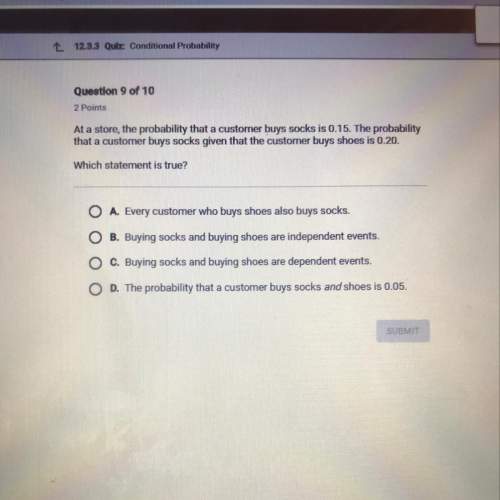
Mathematics, 16.06.2021 01:00 crawford184232323234
1)For the situation, show the work for the four steps to solving the inverse variation problem.
The graph of a function passes through the point (50,3.6), and y varies inversely as x. Find the value of y when x is 75.
A) Calculate the value of k=xy.
B) Write the equation that represents the inverse variation function.
C) Substitute the given value into the function equation and solve to determine the corresponding quantity.
D) Check your solutions by subtracting both quantities back into k=xy.

Answers: 3


Other questions on the subject: Mathematics


Mathematics, 21.06.2019 22:30, sonaihriley
Abucket of paint has spilled on a tile floor. the paint flow can be expressed with the function p(t) = 6(t), where t represents time in minutes and p represents how far the paint is spreading. the flowing paint is creating a circular pattern on the tile. the area of the pattern can be expressed as a(p) = 3.14(p)^2 part a: find the area of the circle of spilled paint as a function of time, or a[p(t)]. show your work. part b: how large is the area of spilled paint after 8 minutes? you may use 3.14 to approximate pi in this problem.
Answers: 2

Mathematics, 21.06.2019 23:00, jetblackcap
Perry observes the opposite parallel walls of a room in how many lines do the plains containing the walls intersect
Answers: 1

Mathematics, 22.06.2019 00:30, madelyngv97
Arandomized controlled trial is designed to evaluate the effect of metoprolol in patients with heart failure. while preparing for statistical analysis, the researcher reviews some common types of statistical errors. which of the following statements is true regarding a type i error in a clinical study? a. the study is not significantly powered to detect a true difference between study groups. bthe null hypothesis is true but is rejected in error. c. the null hypothesis is false but is accepted in error. d. type i error is also known as beta and is usually 0.1 or 0.2. e. type i error depends on the study's confidence interval.
Answers: 1
You know the right answer?
1)For the situation, show the work for the four steps to solving the inverse variation problem.
The...
Questions in other subjects:

Mathematics, 21.05.2020 04:11


Mathematics, 21.05.2020 04:11



History, 21.05.2020 04:11

Health, 21.05.2020 04:11


Social Studies, 21.05.2020 04:11

Mathematics, 21.05.2020 04:11




